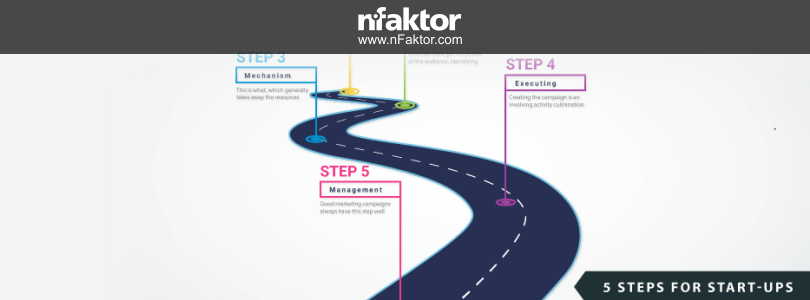Marketing is self consuming, once we get in there is no way we feel we have had enough of it . We always want that additional few likes, Extra viewership, Extra Reads, Extra Leads and such. While we may be right in wanting the ‘extra’ and the ‘additional’ it requires an exceptional campaign to get there. While not all exceptional campaigns require resources, most do. It is therefore important to attempt to create a good clever campaign without the need for resources burning us out. Here are few things to consider
Step 1. Identifying the right audience. Knowing whom we are selling to i.e. the target market whom we want to address is first most important thing. It is important that we understand the profile of the person/s we want to target our campaign to. For example – In a B2B scenario a campaign targeted for Purchase or vendor Management teams could be different from a campaign targeted to CEOs of companies for the same solution, product or services.
Task : List down the profile of the desired audience in a simple excel sheet. (Hints: What type of Companies, Who within the company, His Level of Experience etc.)
Step 2. Messaging. Once we have got the profile of the audience, identifying and creating the right message, for our audience inline with what the audience wants is key. Often times, we get carried away by the exceptional product that we have and focus on it ‘more’ that what our audience wants. A simple example would be our desire to talk about the great underlying technology of our product while the problem that our audience wants addressed is maybe just a simple and secure way to share data over the internet. While technology is important, we would lose crucial attention seconds to technology tidbits which we would rather have for the audience to figure out how to reach us.
Task : List down the simple problems we have set out to solve. It could be technical if the audience we are going after is technical or simple life problems or business problems if the target audience is such. (Hints: Improve data crunching for higher data throughput in a cloud transaction or simple way to identify stock-outs in a retail store). It is important to keep in mind that the same message can be represented in multiple ways. Once we have the messages listed out, brainstorm on them till we arrive at one or two most powerful messages (keeping in mind the delivery mechanism- for e.g. a message for a mail campaign with the reader’s own interpretation could be different from a print message where we could have visuals guiding the message)
Step 3. Getting the delivery mechanism/vehicle right. This is what, which generally takes away the resources. Marketing campaigns are run through expensive media Ads, Print Ads to downright and significantly inexpensive email campaigns. Generally a right combo of multiple delivery mechanisms work. In our case of Start-ups and SMEs, a combination of email campaigns alongside a well designed website and a dose of social media could help create the visibility and therefore the perception of availability. It would not serve the purpose if we reached out with a good email campaign and we did not have a good (within our means) website to support our claims in a campaign email.
Task : As a takeaway a from the step 1 derive the best and the 2nd best possible hang-out where the audience is available , Once we have identified that, the decision of choosing the Delivery Mechanism is a function of the budget and resources . It is important however to know the trade offs in going for the 3rd best hangout due to resource and budget constraints. However, in a IT service/product business the most economical delivery mechanisms may often be the best delivery mechanisms.
Step 4. Creating and executing the Campaign. Creating the campaign is an involving activity and a culmination of our knowledge about our identified audience, understanding the messaging that we want to project, the time we have, tuned for the delivery mechanism we choose. Once we have the above 3 steps in place and we know our budgets, it is a mixture of creativity and resources (that our budgets define) and the available time. Therefore the key here is to assign a budget and identifying the time by when the campaign needs to be executed, for example a holiday season or a Financial year closure. Budgets and time also define the creation of the target pool – the email databases for email campaigns, the Blog topics for Blog campaigns, Phone numbers for Phone-out campaigns etc. (not touching the print and media campaigns which focus more on the content)
Task : This is the most time consuming part of the Campaign Preparation. Our creative team, the marketing Team (Including the leadership) works on developing the content, design and the message. Another team identifies / builds the target market list/database, complete with email IDs, phone numbers, company profile data as required. A plan for running the campaigns is created covering sequential and parallel runs and the plan is executed accordingly.
Step 5. Yield Management – Measuring, tracking and follow up. Good marketing campaigns always have this step well thought out before the campaign is executed. Lack of preparation of post campaign activities can be disastrous. Imagine not having enough sales force to address request for meetings before a holiday season across multiple geographies. The prospect that responded to our campaign of ‘let’s meet’, if not met, will most likely never respond to our future campaigns. Also, not being able to measure the number of responses received , type of responses etc. in mail campaign would deny us of crucial learnings to be accounted for in our next campaign. Our preparation for this activity could also influence our messaging and the vehicle of choice for our marketing campaign.
In all Marketing Campaigns are involved activities, much beyond sending out random emails and tele-calling and the success depends on how much preparation goes behind. While resources are required, smart and less resource intensive ways of campaigning can also yield desirable results.
Task : In case of email Campaigns, create a simple excel sheet with the number of emails sent, day, time, messages and capture the responses, both negative, positive and neutral and build action items for all responses that require action. Collate the info and use the analysis for the next campaign.
Happy Marketing !!







